BRIGHTON JAZZ SUITE
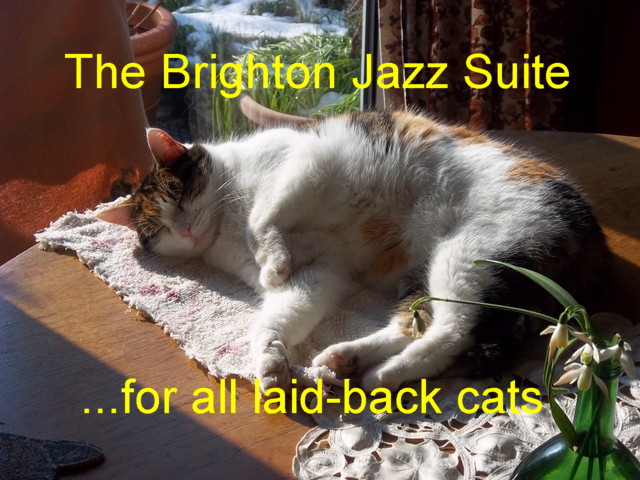
To find out about the arrangements, to hear clips made at rehearsals and see photos of the band, click here
INTRODUCTION
I so much enjoyed writing the Watermill Jazz Suite that I thought it would be nice to write a jazz suite about Brighton, which is only 12 miles away from my home. Although there are still several months to go (I'm writing this on the 27th June 2010) it will not be possible to do a full-blown suite at the gig in the Brunswick in Hove in November, not least because I won't be able to get everyone together for enough rehearsals in the summer months. So I've decided to write and rehearse a few new arrangements which we can play, and then hold another gig sometime in the Spring at which the whole suite can be played. Footnote: it was held on April 24th at the Brunswick.
By basing tunes upon specific localities, people locally can identify with them as they have relevance to their own lives. I've also discovered what a help it is to write music with a given topic in mind, rather than just think up some title or other after the music has been written. There is a wealth of material when you unearth local places and this enables you to paint pictures and tell stories which have some meaning. The topics I have written music about are marked (♪). Click on the titles and you can hear the tunes. Be sure to return to this page afterwards.
SOME FACTS ABOUT BRIGHTON
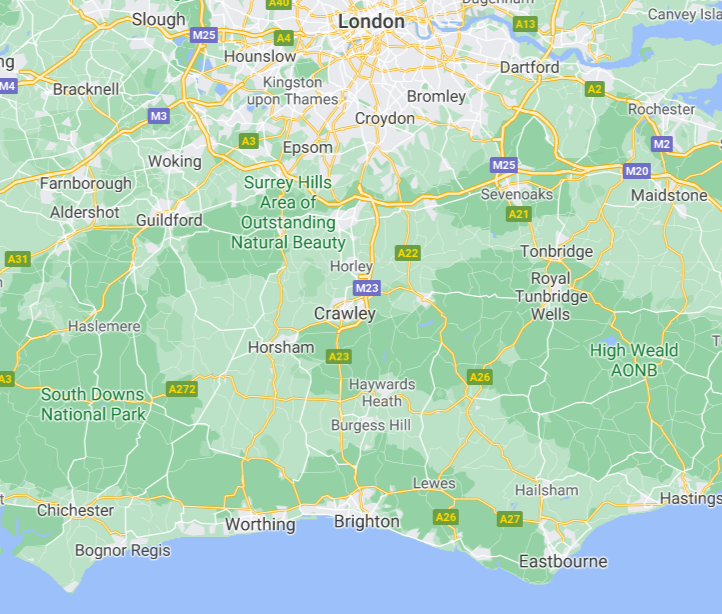
Brighton is half-way along on the south coast in this map.
The connurbation of Brighton and Hove which stretches along the coast from Rottingdean in the east to Portslade in the west lies on the South coast of England, with the South Downs (a range of chalk hills depicted here in light-coloured shading) lying to the north.
Brighton has only been known by that name since the early 19th century. It was earlier known as Brighthelmston, Brighthelmeston, Brichtelmeston, Bristelmestune (I like that one), and before that Beorhthelmes tun - which meant Beorhthelm's farmstead. Going back before he'd built his farmstead, it was probably known as UGG or something like that, as the area has been inhabited since prehistoric times. Along the shoreline, mammoths were hunted by Neanderthal Man while Neanderthal Woman had the job of finding new exciting recipes for cooking them - the mammoths, not the men!
A Neolithic "causewayed enclosure" dating back to 3500 BC or thereabouts was established at Whitehawk on the hills to the east of the town. This predates Stonehenge by up to 1,000 years and is one of Britain's earliest Stone Age Monuments. The word "whitehawk" is believed to be a corruption of "Vied Ac", the Saxon for "holy oak" (♪ Vied Ac) It is believed that these people were cannibals as human remains have been unearthed in a hearth...or maybe the chef got too near the fire.
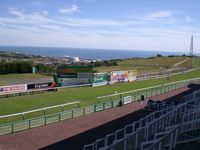
The view from Whitehawk camp today - part of Brighton racetrack. Note the Neolithic mast on the right.
A Neolithic Long Barrow has also been discovered, an idea before its time as the wheel was not invented till much later.
When Palmeira Avenue in Hove was being built in 1856, a bronze age burial mound was excavated. An oak coffin was unearthed, containing bone fragments, a dagger, a whetstone, an axe-head and an amber cup, from 3,500 years ago. The precious amber cup suggests trade links between the area and the Baltic countries. Or perhaps it was just a souvenir! I can imagine the wife of the deceased warrior saying to him: "you went all the way to Norway for your holidays and all you brought back for me was a cup. Well you can keep it!"
Not far from the Old Shoreham Road - the former town bypass - what is known as The Goldstone can be seen. This is likely a corruption of God stone as it once had the appearance of a face. In 1833 the farmer whose land it was on got so fed up with all the tourists coming to see it that he buried it and it was only exhumed 60 years later. Good job that Stonehenge wasn't on his land! The Goldstone is reputed to have been part of a druidic stone circle. The other stones were taken away and used for other purposes.
At Hollingbury, another area of present-day Brighton, a Celtic Iron Age Hill Fort was discovered - Hollingbury Camp, while 10 miles away, Cissbury Ring is thought to have been a tribal capital.
Remnants of the Roman occupation of the area since their arrival in 43AD have also been found. There were villas in Preston Park, Southwick, and near Blatchington; and a Roman road which ran from Shoreham to Hove before going north to Hassocks which was a Roman Industrial Centre. There was also a road beneath the Old Steine near the seafront close to the former River Wellesbourne. (The river was put into a culvert in 1793.)
Incidently, the river created a marshy area in the Steine where fishermen used to dry their nets and where it entered the sea it formed a pool. The pool was covered over by a road (Pool Valley) at the same time as the river was culverted - a time of intense property development. Today this is best known as the bus station for National Express coaches.
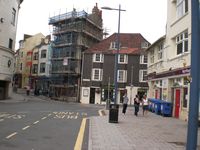
Poole Valley. The building to the right of the one with scaffolding is said to be one of the oldest houses in Brighton.
There may also have been a Roman port south of where the Palace Pier now stands. The Romans left in 410 AD as they got fed up with waiting for the pizza delivery chariot and the Celts and Saxons moved in.
As every English school child knows the Norman invasion took place in 1066. For the benefit of others, these invaders came from Normandy in France. According to the Domesday Book, which was a survey of the whole country made in 1086, Sussex was divided into 6 rapes, ie. land divisions, each centered on a castle and running from North to South: Chichester, Arundel, Bramber, Lewes, Pevensey and Hastings. These large areas were subdivided into Hundreds. Brighton or rather Bristelmestune as it was then called, lay within the Lewes Rape and the Younsmere Hundred, an administrative unit which included Rottingdean, Ovingdean and Falmer. To find out more about rapes and hundreds, go to Wikipedia.
One of the enduring things the Norman invaders did was to build castles and churches. Castles were selectively built at strategic places such as Lewes, but churches were built all over the place. The oldest church in the centre of Brighton is St Nicholas which dates back to the 12th century although St Wulfran's church in Ovingdean, a few miles to the north east, predates it.
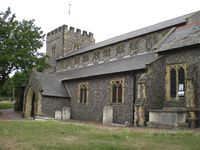
St Nicholas Church.
How strange that the Norman invaders who laid waste to many of the villages in Sussex also built many churches in the area. But understandable, considering that churches were also concerned with social control. To me, they all look like mini-fortresses. In fact the towers of some churches were designed as defensive bastions against invaders.
While on the subject of St Nicholas church, there is a stone plinth in the graveyard. There are various stories about its origin, my favourite being this. Beneath it is buried a knight and a horse in full armour, and on moonlit nights the horse emerges alone and gallops around the churchyard. People coming out of the local pubs believe it anyway. (♪ A Knight at St Nick's)
In what is now central Brighton, Saxon settlements were established in the area bounded by West Street, North Street, East Street and South Street, (not the present one, but one which ran parallel to the coast and was later washed away in the storms of 1703 and 1705.
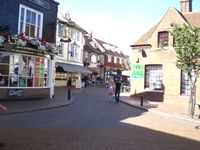
The Lanes - site of the original Saxon settlement.
Like other settlements along the coast (including the original Hove), the hamlet (or manor to be more exact) survived as a fishing and agricultural community. In the Domesday Book the manor of Bristelmestune had to pay a rent of 4,000 herrings. The recipient obviously had a cat with a voracious appetite.
The fledgling town faced two major threats to its existence: attacks by the French and coastal erosion. The most destructive of the French attacks occured in 1514 when Admiral Prégnant, also known as Prior John, burnt the entire town down, the only building which survived was the Church of St Nicholas (♪ 1514) It is ironic that St Nicholas was the patron saint of mariners.
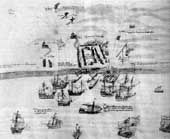
The French raid on Brighton in 1514
In reprisal for this and other attacks by the French, Sir John Wallop commanded an English naval force which destroyed 21 towns and villages in Normandy.
I think you could assume that the English and French did not get on very well together for hundreds of years. Following the Norman invasion there were conflicts between the two countries in 1139, 1147, 1153, 1242, 1324, 1357-1453, 1511-1559, 1688-1697, 1702-1713, 1740-1748, 1756-1763, 1775-1783, amd 1792-1815. The reasons behind many of these battles were conflicting claims to land or to the throne: a pointless loss of life. Why couldn't the leaders just toss a coin! Perhaps because there might have been a war over which coin to toss - an English one or a French one. Being on the south coast close to France made Brighton particularly vulnerable to attack.
Control over the shipping channel was also important for the governments and for the many smugglers in the area. In fact in the 16th century the residents of Seaford a few miles to the East were known as "shags", not because of what you might think, but because of their enthusiasm for looting ships. They also caused ships to run aground through the use of false harbour lights. Today they are no longer known by this term, in fact you could say they are completely shagged out.
As for coastal erosion, there was reputedly a tsunami in 1014 and damaging storms in 1703 and 1705 About the 1703 storm, Daniel Defoe wrote: "Stript a great many houses, turn'd up the lead of the church, overthrew two wind-mills, and laid them flat on the ground, the town in general (at the approach of daylight) looking as though it had been bombarded." (♪ 1703)
Earlier on than this, the nearby port of Shoreham had hit the news. Following the Royalists' defeat in the Battle of Worcester (3rd September 1651), King Charles 11 fled from Cromwell's forces to Shoreham where a certain Captain Nicholas Tettersell (or some say Tattersall or Tattersell) took him on board his boat, the Surprise, and sailed off to France under the cover of darkness.
After the restoration of the monarchy in 1660, the ship was renamed The Royal Escape and became a ship of the Royal Navy. As for Tettersell, he went on to captain another ship in the Royal Navy before retiring and becoming landlord of the Old Ship Inn in what is now, Brighton. The annual Royal Escape yacht race from Brighton and Shoreham to Feacute;camp in France commemorates this event. (♪The Royal Escape)
From being the largest settlements in Sussex with a population of 4,000 in the 1640s, there were only 2,000 in the mid 18th century, owing to the effects of another destructive storm in 1748 and to the fall-off in demand for the fish. Unfortunately, the opening of fish and chip shops - the first one in London in 1860 - came too late.
The upturn for the town can be traced back to one man in particular, Dr Richard Russell from the nearby county town of Lewes. In 1750 he published a paper about the benefits of sea bathing and drinking sea water. He built a house in Brighthelmstone where the Albion Hotel now stands in the Steine near the sea-front for his own use and for the use of his patients. When he died in 1759 the house was let to seasonal visitors including the Duke of Cumberland, the brother of George III.
In 1783, the Prince Regent visited him (his uncle) and liked the town so much that he patronised the town for the next 40 years.
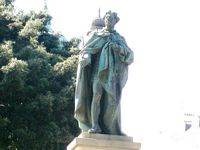
The Prince Regent showing his Regency-style legs
He was also told that sea-bathing would be good for his gout. In 1786, the Prince Regent, later to become King George IV, rented a farmhouse not far from Russell's house and this was rebuilt to become the Royal Pavilion, adopting the Indo-Saracenic style, which is influenced by Indian and Islamic architectural elements. The interior designs heavily drew on Indian and Chinese styles (♪Pavilion)
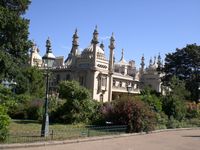
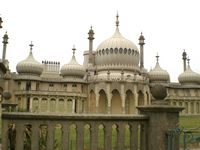
The Royal Pavilion
Apart from the bathing and the design of the Pavilion, the Prince Regent had other things on his mind, namely, his mistress, Mrs Fitzherbert - a widow, who had a house a short distance away and there is a rumour that a tunnel linked the two buildings. He had married her the previous year in 1785 but the marriage was considered invalid as he did not have his father's permission to marry her and she was a Roman Catholic. The Prince Regent therefore originated the idea of having a dirty week-end in Brighton.
Maria Fitzherbert's House, now the YMCA
For political reasons and because he was heavily in debt in 1795 he married his cousin, Caroline of Brunswick - which was then an independent principality. Lord Malmesbury wrote in his diary on 20th November 1794 that she lacked judgment, decorum and tact, spoke her mind too readily, acted indiscreetly, and often neglected to wash, or change her dirty clothes. At the marriage ceremony George IV was drunk and complained that she was "unattractive and unhygenic."
Anyway, these developments led to the start of sea-bathing in the town and the spate of new housing developments in Brighton and Hove in the Regency style.
Sea bathing was not as it is now. Bathers - women on the east side of town and men on the west side went down to the sea in Bathing Machines and then were dipped into the water by dippers in the case of women, the most famous of them all being Martha Gunn, the "Queen of the Dippers". She was also a friend of the Prince Regent (♪Martha Gunn.)
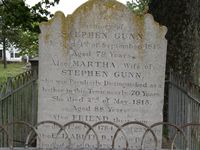
Martha Gunn's Grave in St Nicholas Churchyard
Men were dipped by "bathers". Mixed bathing was not allowed until 1901
As an alternative to bathing in the sea, a Doctor Awsiter in 1769 had the idea of hot and cold baths in, appropriately enough, Poole Valley, close to Russell House.
One of the most prolific teams of architects who designed the new buildings was Sir Charles Augustin Busby (no relation to me as far as I know) and Amon Wilds (♪I'm just Wilds about Busby. That one features Mark Bassey. This version features Barnaby Dickinson). They designed Brunswick Terrace and Brunswick Square in Hove which had its own police force, market and riding school and under an Act of Parliament, the houses had to be painted every five years.
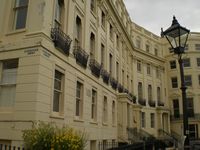
Houses in Brunswick Square
To my knowledge this Act is still in force. The property speculator and Lord of the Manor, Thomas Reed Kemp also commissioned them to design new developments on the East side of town which is now called Kemptown. Sussex Square is the biggest crescent in Britain, larger then Grosvenor Square in London and the Royal Crescent in Bath.
The sudden popularity of the town (in the 1830s it was the most popular seaside resort in Britain) was reflected in various new amenities. A Chain Bridge was opened in 1823 for steamers which plied their way to France, now that peace finally existed between the two countries. The West Pier was built for steamers that were too large to dock at the Chain Bridge and opened in 1866. Steamers also left here for the Isle of Wight. It is interesting that Queen Victoria who had got fed up with the "indescreet and troublesome" inhabitants of Brighton no longer came for her holidays to the Pavilion after 1845 but chose to go instead to Osbourne House. Where? On the Isle of Wight.
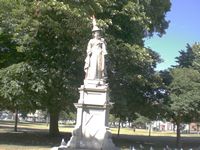
Queen Victoria wearing a regal traffic cone
In 1891 the Palace Pier was opened.
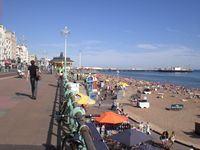
The Palace Pier and seafront
The Chain Pier just to the east of it was destroyed in a storm in 1896 although some of the artefacts were used in the Palace Pier. The new Palace pier was merely for amusement purposes however, as the port of Newhaven some miles to the east was now being used as a ferry port for France. The West Pier was closed in 1975 and fires and storms in 2002 and 2004 left it in ruins.
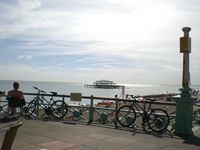
The West Pier
Along the seafront Madiera Drive, a covered walkway, was constucted for people to parade up and down, a custom which has continued to the present day along the seafront, with most of the people urgently trying to find public conveniences which are still open.
For people who preferred not to walk, an electric railway was built by a certain Magnus Volk - the first electric railway in the world (♪ Volk's Song). He was also responsible for time ball in the clocktower in the centre of Brighton. The hydraulically-operated ball rose up to the top of a mast before falling to the ground on each hour. This feature was removed on public demand because of the noise it made.
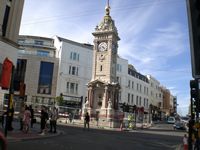
The Clocktower
In addition he also dreamed up a very strange project which involved a tram which was nicknamed the Daddy Long Legs. Volk wished to extend the tramway to Rottingdean, some 2.8 miles to the east of Brighton. But because this would mean negotiating a steep gradient, he had the idea of a "tram" on 4 legs which would run over the sea itself. Wheels at the end of the legs ran on a track built into the seabed and powered by an overhead electric cable. The Pioneer, as it was named, ran for a week in 1896 but was then damaged by a ferocious storm. Other problems arose and the whole thing was scrapped a few years later. Anyone wishing further information about it can read about it here.
The coming of the conventional railway in 1841 also increased the popularity of the town and made it possible for people to commute to London from Brighton. This is sometimes called the Brighton Line, as heard in bingo calls, but in fact that was named after the number 59 London to Brighton bus service. The Brighton, Hove and Preston United Omnibus Company - now called the Brighton and Hove (bus company) was started in 1884. The company has won lots of awards including the highly prestigious UK Bus Operator of the Year in 2009 (♪The Omnibus Edition)
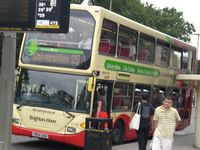
Brighton and Hove bus
The Victorian era also saw the construction of an aquarium built in 1872 and lots of new houses, shops and roads, including Queens Road in 1845 which connects the older part of town to the station. Nearby are the North Laines, an area which at the time of the construction of Queens Road, and for a long time afterwards, was noted for its squalor, overcrowded living condition and its large number of slaughterhouses. (The Sussex word laine refers to a legal term for a kind of land holding.) The (North) Laines are not to be confused with the Lanes near the seafront.
During the First World War (1914-18), one and a half million Indian soldiers fought for Britain and some of the 12,000 injured Indian soldiers on the Western Front were taken to make-shift hospitals in Brighton, including the Pavilion which took care of 6,085 of them. A memorial to some of those that died - the Chattri - can be found in Patcham, in the far northern part of the town, where some of them were cremated
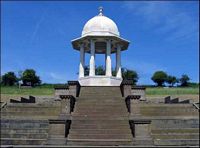
The Chattri
The First World War was a very unsettling time for the British. It is said that the Battle of the Somme in June 1916 could be heard on the playing field of Brighton College during cricket. Enough to put you off your game.
Brighton fared badly in the second world war. On July 2nd 1940 the beaches were closed and were mined and 30,000 people were evacuated from the town. There were 56 recorded bombings between July 1949 and February 1944. On September 14th 1940 the Odeon Cinema in Kemp Town was bombed killing 55 people there and in the surrounding area. On 25th May 1943 some 25 to 30 Geman aircraft attacked the town. Some 22 bombs were dropped and the streets were straffed in a 5 minute raid. A total of 24 people were killed, 58 more were seriously injured and 150 houses were made uninhabitable with 500 people made homeless. Part of the railway viaduct on London Road was destroyed and there was severe damage to railway workships and rolling stock. By the end of the war 198 people had been killed during the air raids.
Things could have been more drastic however. Under Operation Sea Lion, Hitler intended to invade Britain, with sea-borne forces landing on the south coast between Ramsgate in Kent and the Brighton/Worthing area with parachutists landing in the Ditchling area on the South Down hills just north of Brighton. The invasion was cancelled because of the outcome of the Battle of Britain. Had the invasion occured Brighton and the rest of the country would have been very different nowadays.
Why Hitler thought of landing parachutists at Ditchling is an odd choice. Maybe it was because that would be the future home of Vera Lynn, the "forces sweetheart" during the war. Or maybe he thought the parachutists might fancy a bit of sight-seeing and a picnic at the nearby Devil's Dyke - a local beauty spot with a very steep hill leading to Brighton.
Legend has it that the devil wanted to flood all the churches in that area so he dug out a ditch which he hoped to dig as far as the sea a few miles away. But an old woman with a candle and a sieve came along and a cockrel crowed while he was at work. This startled the devil who heard the cockrel and saw the light of the candle through the sieve and thought it was morning which caused him to flee. Why he didn't come back the next night and carry on where he left off is not accounted for in the legend.
The post-war period was a time for more housing construction and tourism flourished again. In 1961 the University of Sussex was opened although plans for a University to serve the town date back to 1911. The University is rated as one of the best in the country - but I would say that, as I went there. In 1992 the former Brighton Polytechnic was renamed as the University of Brighton. The Polytechnic had grown out of an accumulation of other educational institutions, the earliers of which was the Brighton School of Art which opened in 1859 in the kitchen of the Royal Pavilion. This might explain the enormous number of paintings of Georgian-style saucepans dating from then. (Only joking.) (♪ B...righton).
The 1970s and 80s were marked by social unrest with high numbers of unemployed, sub-standard accomodation and high crime rates. In 1984 Patrick Magee, a member of the Provisional IRA (Irish Repubican Army) planted a bomb in the Grand Hotel on the seafront intending to kill Mrs Thatcher and other members of the Conservative Government who were staying there for the party conference. She escaped injury but 5 people died and others were injured.
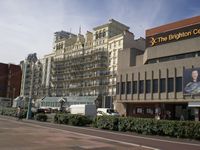
The Grand Hotel, Brighton
From 1971 to 1979 work took place in constructing Brighton Marina to the east of the town amid some controversy. A new football stadium has now been built at Falmer which also caused controversy. The Marina is now a well-established amenity and no doubt soon the stadium will seem as if it's always been there.
Hove has always regarded itself as a more refined place. Some people claim that it was Lawrence Olivier who came up with the phrase "Hove, actually" when asked where he lived. (♪ Hove, actually)
.In 1997 the towns of Brighton and Hove combined to form a Unitary Council and in 2000 it became a city although remaining part of the ceremonial county of East Sussex. The population was approximately 256,600 in 2008. (Treat these figures with some leeway as sources differ.) Some 9.2 percent are of non-white ethnic groups. 48,000 residents are over the age of 60. There are a large number of young people and students who live in the town during term time. Brighton is also known for the fact that 21 percent (40,000) of the population are in the Lesbian, Gay, Bisexual and Transgender (LGBT) category.
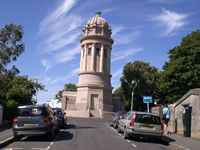
Tower in Queen's Park
In 2004 it became a Fairtrade Town awarded by the Fairtrade Foundation and before that in 1987 it was awarded U.N Peace Messenger City status.
On a lighter note, the Brighton Festival was founded in 1966, and it is the largest multi-art form festival in England. There are some excellent shops in Churchill Square ...(♪ Churchill Square Dance)
Churchill Square Shopping Centre
...and along Western Road and North Street, including 3 branches of Taj which sells fruit and vegetables from all over the world.
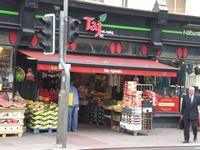
Taj
Social problems - unemployment and homelessness, in particular - still exist. People from other parts of the country however do not think about this when they decide to move to Brighton, and for many of them, their dreams are shattered by harsh reality (♪Illusions (1st part)). For others though, Brighton and the surrounding area is a great place to live.
The first performance of the Brighton Jazz Suite was held on 13th May 2012. The Mayor of Brighton kindly attended with her escort/husband. To hear the piece I wrote at the last minute for her, have a listen:
To read about the process of writing the music and to see some photos of the band taken in Brighton, turn to the next page.
Some sources: https://www.mikeperris.com/brighton/neolithic.html
https://en.wikipedia.org/wiki/History_of_Brighton
https://www.yeoldesussexpages.com/history/hishove/hovesto1.htm
https://en.wikipedia.org/wiki/Brunswick_%28Hove%29
https://www.arthurlloyd.co.uk/Brighton/PalacePier.htm
https://www.mybrightonandhove.org.uk/index.aspx
Also many other cross references in and from Wikipedia.